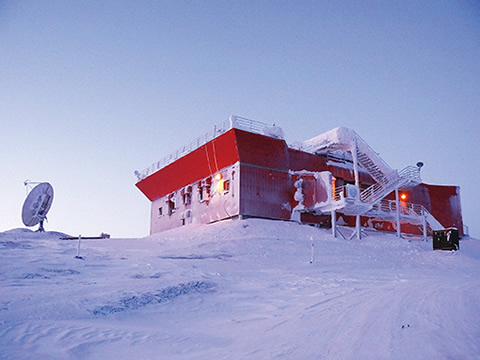Researchers from the Dunlap Institute for Astronomy and Astrophysics are taking the search for other worlds to a new frontier: the Canadian Arctic. Beginning in January, astronomers for the first time will use the long, dark winter in the country’s Far North to search for planets circling other stars and unravel the mysteries of such fleeting cosmic phenomena as supernovas.
The project takes advantage of the hundreds of hours of continually clear, dark skies during the Arctic winter to make observations not possible during the short and sometimes cloudy nights at lower latitudes where the world’s leading observatories are located. “We’re learning how to do astronomy in the Arctic and we’ve got our eyes on doing much larger things in the future,” says Nicholas Law, a Dunlap fellow.
Law and his colleagues will use a super-sensitive digital camera to photograph a wide swath of sky around Polaris, the North Star. Next winter, researchers plan to add a $100,000, half-metre telescope that will record 50,000 star-filled images during the four months of Arctic night. Both devices will be located at the Polar Environmental Atmospheric Research Laboratory on the west coast of Ellesmere Island at 80 degrees north, but can be sent instructions from Toronto and adjusted robotically.
Prof. Raymond Carlberg, a co-investigator on the wide-field camera, is especially interested in nearby supernovas and how they develop. Because supernovas tend to flare up suddenly and fade quickly, usually within a few weeks, large observatories often miss them; they focus for extended periods on precise, predetermined targets.
The Arctic wide-field camera will initially record two images every minute spanning about one-fiftieth of the entire sky (many times what a large observatory covers). Future versions of the camera will cover as much as one-quarter of the sky. If a supernova flares, the U of T researchers should be able to track it back in time by examining previous images. “Supernovas are one of the best tools we have for understanding dark energy,” says Carlberg. “We need to better understand their physics.”
The Arctic camera and telescope will also be used to search for other worlds orbiting stars in our own neighbourhood of the Milky Way galaxy. Law intends to concentrate on M-dwarf stars, which are substantially smaller than our sun. “These stars are so small that a planet passing in front of them creates a bigger proportional drop in the light transmitted thus making detection easier,” he says.
Carlberg contrasts the low-cost but pioneering Arctic observatory to big-ticket astronomical projects, which can take decades to get underway: “That’s the beauty of these small things. We can talk to a few people and get going. And we can involve students in a more substantial way. ”
Recent Posts
U of T’s 197th Birthday Quiz
Test your knowledge of all things U of T in honour of the university’s 197th anniversary on March 15!
Are Cold Plunges Good for You?
Research suggests they are, in three ways
Work Has Changed. So Have the Qualities of Good Leadership
Rapid shifts in everything from technology to employee expectations are pressuring leaders to constantly adapt





